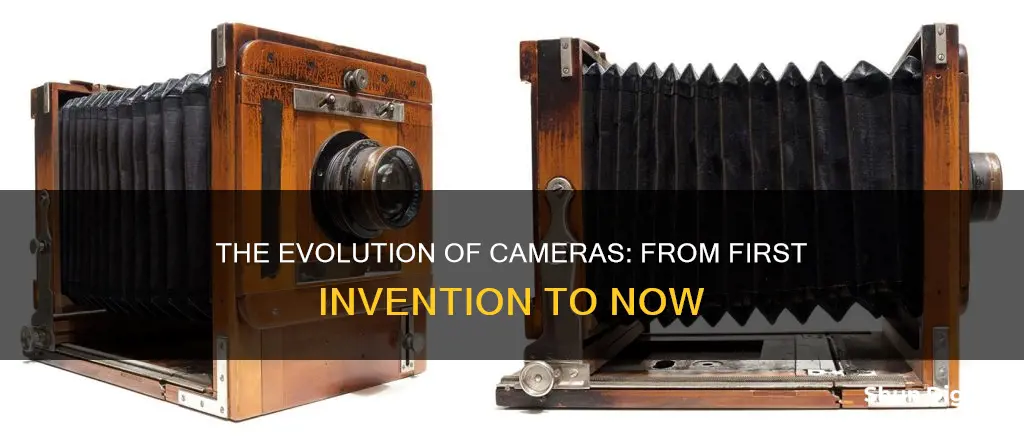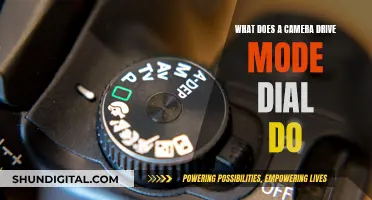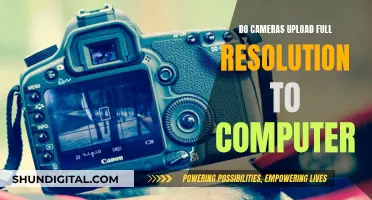
The history of the camera is a long and fascinating one, with the first devices we would recognise as cameras being invented in the early 19th century. However, the origins of the camera can be traced back much further, with the camera obscura – a small, dark room with a pinhole to let light in – being used as far back as the 5th century BC.
The first camera capable of capturing an image was invented by French inventor Joseph Nicéphore Niépce in 1816. This simple camera used paper coated with silver chloride to produce a negative image. Niépce later experimented with other substances, eventually discovering that a film made from Bitumen of Judea, mixed with pewter, could produce permanent photographic images when exposed inside a camera obscura. He called this process heliography.
The first photographic camera was also developed by Niépce, who in 1826 created the first permanent photograph of a natural scene. This photograph, taken from the upstairs windows of his family home in Le Gras, France, is now considered the world's first photograph.
In the following years, several inventors built on Niépce's work, refining the photographic process and making it more accessible to the masses. Notable figures include Louis Daguerre, who invented the daguerreotype – an early form of photo camera that produced positive images – and William Henry Fox Talbot, who invented the calotype, a camera that used writing paper soaked in salt and brushed with silver nitrate to capture images.
Today, cameras are an integral part of our daily lives, with digital cameras and camera phones allowing us to capture and share images with the world in an instant.
| Characteristics | Values |
|---|---|
| First camera ever made | Camera obscura |
| Inventor of the first camera | Unknown, but the oldest written records are by Han Chinese scholar Mozi (c. 470 to c. 391 BC) |
| Date of invention | Pre-17th century |
| First photographic camera | Invented in 1816 by Joseph Nicéphore Niépce |
| Inventor of the first photographic camera | Joseph Nicéphore Niépce |
| Date of invention of the first photographic camera | 1816 |
| First permanent photograph | Taken in 1826 by Joseph Nicéphore Niépce |
| First mass-marketed camera | Daguerreotype camera produced by Alphonse Giroux in 1839 |
What You'll Learn
- The first camera was invented in 1816 by French inventor Nicephore Niepce
- The first permanent photograph was taken in 1826 by Joseph Nicephore Niepce
- The Daguerreotype was the first mass-produced camera
- The Kodak Brownie was the first camera for the masses
- The first digital camera was created in 1975 by Steven Sasson

The first camera was invented in 1816 by French inventor Nicephore Niepce
Niepce's interest in photography was sparked by his acquaintance with the camera obscura, a drawing aid popular among affluent dilettantes in the late 18th and early 19th centuries. The camera obscura projects a fleeting image onto a surface, which Niepce sought to capture permanently. In May 1816, he produced the first image of nature: a view from a window. He called these images "retinas".
Niepce continued to experiment with various substances that were affected by light, eventually concentrating on Bitumen of Judea, a naturally occurring asphalt. He dissolved the bitumen in lavender oil and thinly coated it onto a sheet of metal. After sufficient exposure, the solvent could be used to rinse away the unhardened bitumen, leaving behind a positive image.
In 1826 or 1827, Niepce adapted the camera obscura to generate a permanent photographic plate, thus creating the first camera. He called his process "heliography", or "sun drawing". The oldest surviving photograph, taken in 1826 or 1827, is on display at the University of Texas at Austin. It depicts a view from the window of his estate in Le Gras, France.
Camera Bulb 360: Night Mode Malfunction Explained
You may want to see also

The first permanent photograph was taken in 1826 by Joseph Nicephore Niepce
Niepce's pioneering work was soon overshadowed by the invention of the daguerreotype. In 1829, he formed a partnership with Louis Daguerre, a French artist, to continue experimenting with heliography. However, Niepce died in 1833, and his contributions were largely unrecognized. Daguerre succeeded in developing a high-contrast and extremely sharp image, and by 1837, he was able to fix the images with a common salt solution. He called this process the daguerreotype, and it became the first practical photographic process.
How Masking in Adobe Camera Raw Transforms Photos
You may want to see also

The Daguerreotype was the first mass-produced camera
The process of making a daguerreotype involved polishing a sheet of silver-plated copper to a mirror finish, treating it with fumes to make its surface light-sensitive, exposing it in a camera for as long as necessary, and then developing the resulting latent image by fuming it with mercury vapour. The image was then fixed by removing its sensitivity to light through a liquid chemical treatment, rinsing and drying it, and sealing it behind glass in a protective enclosure.
The daguerreotype was almost completely superseded by 1856, with new, less expensive processes such as the ambrotype yielding more readily viewable images. However, the daguerreotype experienced a minor renaissance in the late 20th century and is currently practiced by a handful of devotees worldwide.
The first daguerreotype camera was built by Alphonse Giroux in 1839. The camera was a double-box design, with a landscape lens fitted to the outer box, and a holder for a ground glass focusing screen and image plate on the inner box. The inner box could be slid to bring objects at various distances into focus. The early daguerreotype cameras required long exposure times, ranging from 5 to 30 minutes.
Charging the Olympus SZ-14 Camera: A Step-by-Step Guide
You may want to see also

The Kodak Brownie was the first camera for the masses
The history of the camera is a long and fascinating one, stretching back to the camera obscura of the 16th century. However, the first camera for the masses was the Kodak Brownie, released in 1900. This was a simple cardboard box camera with a convex-concave lens, conceived and marketed to sell Kodak roll films.
The Brownie was the first in a series of camera models made by Eastman Kodak, and it addressed a key issue: the cost factor. Before the Brownie, photography was largely an activity for experts or wealthy hobbyists. The Pocket Kodak, for example, would have cost most British families nearly a month's wages. The Brownie, on the other hand, was initially priced at just $1 (equivalent to $37 in 2023) and the low price of Kodak roll film and processing meant that photography became accessible to everyone.
The Brownie was aimed at children, with Kodak using the popular "Brownie" characters from Canadian writer Palmer Cox's books to market the camera. More than 150,000 Brownie cameras were shipped in the first year of production and it was a huge success. An improved model, the No. 2 Brownie, was released in 1901, producing larger photos and costing just $2.
The Brownie was a basic but effective camera, allowing people to take quick and easy photographs or "snapshots". Its simple controls and low price meant that it surpassed its marketing goals, achieving broader appeal than expected. Although it was initially marketed to children, the Brownie was soon adopted by adults who realised that despite its simple design, it could produce very good results.
The Kodak Brownie played a significant role in democratising photography and effectively challenging the privileged setup of the time. It introduced the snapshot to the masses and turned photography into an everyday activity, with people photographing events, vacations, places they were visiting, and anything that captured their interest. The Brownie series, with its various models, captured first-hand, raw, and authentic narratives of some of the critical events in history more than any other cameras of the time.
Maximizing Mirrorless Camera Battery Life: Top Tips to Consider
You may want to see also

The first digital camera was created in 1975 by Steven Sasson
The history of the camera is a long and fascinating one, stretching back centuries before the advent of digital photography. The first cameras were very different from the modern ones we use today. The camera's evolution can be traced back to the camera obscura, which was a dark room or box with a small hole or lens that projected an inverted image onto the opposite wall. This principle was first explained by Han Chinese philosopher Mozi around 470 to 391 BC, and it played a significant role in the development of photography.
Fast forward to 1816, when Joseph Nicéphore Niépce created the first-ever photograph using a camera obscura, marking the birth of photography. He achieved this by using a light-sensitive material called "Bitumen of Judea" or "Asphalt of Syria", which hardened in response to light exposure, creating a permanent image. This process, which he named heliography, or "sun drawing," took multiple days of exposure time to capture an image.
In the following years, several inventors made significant contributions to the development of photographic cameras. Louis Daguerre, partnering with Niépce, introduced the daguerreotype in 1839, which produced higher-quality images with shorter exposure times and was more portable. However, the daguerreotype was still not widely accessible due to its cost.
The first photographic camera available to the public was produced by Alphonse Giroux in 1839. This camera used standardized plates that could be purchased in different sizes, had an exposure time of 5 to 30 minutes, and cost around $7,000 in today's money.
The journey to modern cameras continued with the introduction of gelatin dry plates by Richard Leach Maddox in 1871, which reduced exposure times significantly. George Eastman's Kodak camera, released in 1888, further revolutionized photography by offering a roll film camera with 100 exposures at an affordable price.
Finally, we arrive at the first digital camera. In 1975, Steven Sasson, an engineer at Eastman Kodak, created the first self-contained (portable) digital camera. It weighed 8 pounds (3.6 kg) and recorded black-and-white images onto a compact cassette tape. The images were low resolution, at 0.01 megapixels, and it took 23 seconds to capture each one. While this early prototype was not intended for production, it paved the way for the digital photography revolution.
Sasson's invention earned him the National Medal of Technology and Innovation from President Barack Obama in 2009 and the Progress Medal from the Royal Photographic Society in 2012. Today, his original digital camera is on display at the Smithsonian Institution's National Museum of American History in Washington, D.C.
Capturing Sports Action: Keeping Your Camera in Sports Mode
You may want to see also
Frequently asked questions
The first device we recognise as a camera was invented in 1816 by French inventor Joseph Nicéphore Niépce.
The first camera was invented by French inventor Joseph Nicéphore Niépce.
The first camera was called the heliograph, or the camera obscura.
The first cameras were large and cumbersome, and images had to be manually traced as no photographic processes had yet been invented.
The first photograph was taken in 1826 or 1827 by Joseph Nicéphore Niépce.







